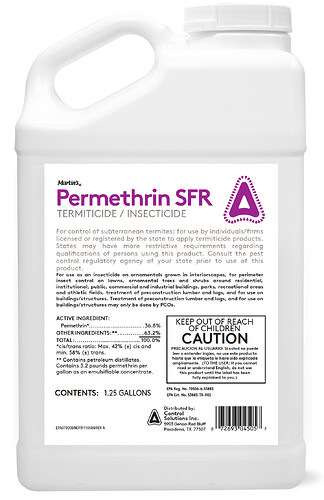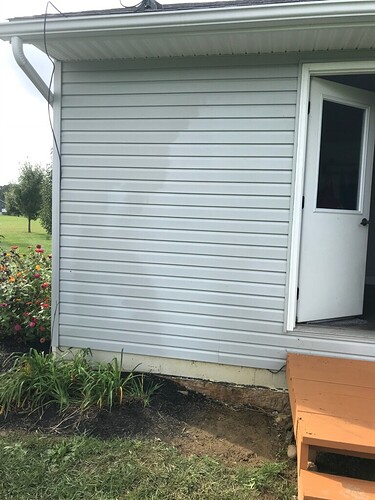I just got a call from a pest control company that had just treated a house. It seems as though their spray took off some of the oxidation and it’s very obvious where the spray hit. The home owners are cool about it but want it cleaned up. I am going to take a look later today or tomorrow and will see what I’m up against. I am wondering if anyone here has had the same situation and what it took to clean it all up? My first thought was having to scrub the whole house by hand like others have had to do when they have removed some oxidation. Or I have read spraying it with F13 to avoid scrubbing.
I just cleaned the house of the owner of the Pest Control company (great guy) and this could secure a lot of business for me down the road if I can fix it. He is in fear of having to re-side the house.
It might help to ask the pest control company to tell you what exact pesticide they sprayed was and then contact tech support for the product to find out what they can tell you.
I have some limited experience spraying commercial pesticides and sometimes their are warnings on the labels about discoloration. I’m pretty sure they might be able to share some info dealing with it if you speak to them directly.
Petro based or oil based
Permethrin insecticide
Permethrin (“per-meth-rin”), on the other hand, is a synthetic, man-made insecticide, whose chemical structure is based on natural pyrethrum. The so-called pyrethroid insecticides were developed to match or exceed the effectiveness of natural pyrethrum but be more stable in sunlight. Pyrethroid insecticides are used in agriculture because of their stability in sunlight.
This is the product he used.
OIL of citronella is the main ingredient in permethrin, I have not seen this question asked in years, good question & great leg work on the permethrin Cougar_Bait . 409 will remove the oil but you could use a dilute degreaser that’s not to say it will blend the area, probably gonna have to treat entire side
I have a call in to the Ohio sales rep. But I also just got a couple pictures from the homeowner. The house is only three years old and they power wash it themselves each summer. I asked if they got up close and blasted away the dirt and she said yes. I just heard back from the exterminator and he said that these marks are not how he usually sprays. It’s raining up here now and I won’t get over to the house until Thursday or Friday to see for myself but these pics kind of look like too much pressure was sprayed and didn’t cover everything.
There trying to get a free fix from their mistakes by trying to blame the pesticide company. Even if the pesticide company is at fault
Get yourself out of that fiasco…
RUN AWAY!!
I’d spray a strong mix of EBC, like 5-10 to 1 net. In other words, drop your injector tube into straight EBC. Let dwell 5-10min and rinse. It’ll break down the oil but also if the house is only 3 years old, it should take care of any oxidation, if any. Three years old pretty new to have bad oxidation, might have a little just starting.
I hear what you’re saying and I would probably think the same if I didn’t know the situation. The Pest Control guy is a friend and has asked me as a last effort to try and see if I can fix this before he has an insurance adjuster come out. He always does what is right for his customers. He knows this isn’t his fault but will still make his customer happy by paying me or making an insurance claim if need be. He has done a lot of work for their extended family over the years and has a well established business in the area.
It’s not from the homeowner power washing. Doesn’t look like wand marks. You can see it bleeding down the grain of the siding. It definitely is a liquid. I’d blame the exterminator too.
Oil doesn’t take off oxidation, but it will hide it. If you ever try to sell a car or something with faded plastic parts, rub some automatic transmission fluid on there. It brings the color back and makes them look nice and shiny for a few weeks. One of my favorite tricks. I think the same thing is going on with this siding. The problem will sort itself out. There was a thread on here somewhere about sunscreen. Same thing.
I admit, the customer won’t like that answer. Washing it would probably help. @Racer has a pretty good sounding plan. I also vaguely remember @CaCO3Girl explaining how one chemical is better for petroleum and one is better for plant oils. Maybe she could recommend something better for the insecticide.
Thanks for the tag @instock instock.
@Cougar_Bait Have you actually looked at the siding? I’ve seen a pesticide “bleach” siding, so before you commit you should really take a look and see if it’s an oil. There are many different ways for a pesticide to be carried, oil is just one of them.
If it is an oil Glycol Ether EB is the best shot at getting it off. It’s usually in a purple mixture with sodium hydroxide. Purple power, purple magic, purple whatever. Take a bottle with you and test it.
I am planning on looking at it Thursday or Friday of this week. I am only going off what the homeowner said and the exterminator said. There are no marks on other sides of the house (only 2 sides that get most of the sun) which leads me to believe that oxidation is a factor here and not the pesticide on the vinyl. Also, the fact that the exterminator said that he wouldn’t have sprayed in those areas. He has used this insecticide (Permethrin) for years and never had an issue. Would I be able to feel the oil on the siding if that’s what it is?
So, as you know I work as a chemist. Part of my job is EPA pesticides, they are complicated things with all the state registrations and what not. I searched in the database and found the label for “Permethrin E-Pro”, this is an EPA registered pesticide with the EPA registration number 79676-2.
On every label of every pesticide certain phrases are used. It’s almost amusing how similar a bathroom cleaner label is to one that sanitizes hospital equipment, but I digress. My point is that every EPA pesticide label has certain phrases they are REQUIRED to use by law. I found a phrase on this label that isn’t required, it’s actually very telling:
Note: When applying to or around vinyl siding, treat a small test area in a non-obtrusive
area and allow to dry. Some types of vinyl siding, particularly if aged or weathered or during
periods of high temperature or high humidity may show some staining after application
of an emulsifiable concentrate product.
Staining may also occur on certain surfaces such as brick, cinder block, stucco and wood.
Immediately remove spray deposits on painted or stained surfaces or finishes by washing
with soap and water to prevent discoloration. Do not apply to surface where visible spray
residues are objectionable.
My experience was with a different pesticide of the same family. It caused the siding to yellow, it was an actual chemical reaction, no way to undo it. So, take the purple stuff and try to clean it away with some elbow grease, but you may not be able to is what i’m saying.
Did not know but that is great and I appreciate your help. This is the actual product used.
I would assume it is very similar but noticed it has a different EPA registration #.
So to be clear, you are saying to try something like Purple Power degreaser (diethylene glycol monobutyl ether) that I can pick up at Walmart or an Auto parts store? Do you know if something like EBC is stronger (I’m assuming it is) and worth a shot like Racer said?
That label has this warning:
Broadcast Treatment for Control of Nuisance Pests: Apply using a 0.5% emulsion as a
residual spray to outside surfaces of buildings including, but not limited to, exterior siding,
foundations, porches, window frames, eaves, patios, garages, and refuse dumps.
I am pretty sure that with that amount of Permethrin that a similar warning should have been placed on this bottle by the manufacturer.
Yes, purple power degreaser used straight should work well. I have not worked with EBC, the SDS says it’s IPA (rubbing alcohol) and surfactants. IPA loves both water and oil so that is a good choice to attempt to remove an oil. Maybe you should take both?
Spoke with the Ohio rep at Control Solutions. He said it shouldn’t cause a stain on vinyl siding. He viewed the pictures and said it doesn’t represent a spray pattern from a pest control application. I confirmed with the exterminator that the % was correct and not somehow mixed in with another chemical. He just got back from there and used the same chemical on another spot on the house to see if anything happens. We are going back out tomorrow to check it out. I also found out that the home owners sprayed something on it from Lowe’s after the fact. I have to wonder if that made it worse.
update?? @Cougar_Bait
Well, both the Gutter Grenade and Purple power seemed to be working as I could see dirt/grease running down. I scrubbed with a brush and it seemed to bring it back to the original color. We had high hopes after the test spots. However, a couple hours later the homeowner sent a picture showing the stains still there. I have some EBC coming and will try that as a last ditch effort. Other than that, he is making an insurance claim.
EBC won’t work…
Now your names involved in this mess. Hopefully the homeowners don’t go around trashing your business name as well.
Kudos for trying though, hopefully a good lesson.





